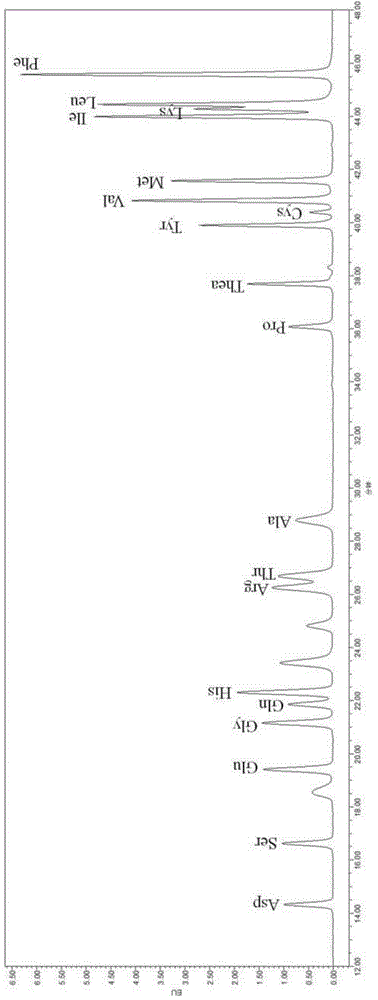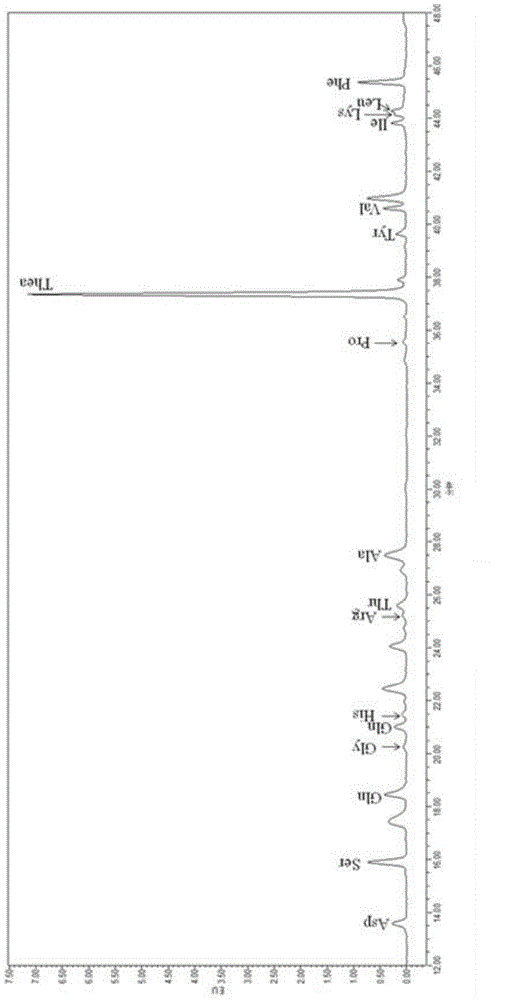Method for detecting free amino acids in tea by using reversed-phase high-performance liquid chromatography
A reversed-phase high performance liquid phase, free amino acid technology, applied in the field of analytical chemistry, can solve the problem of not containing glutamine, and achieve the effect of simple sample pretreatment and low cost
- Summary
- Abstract
- Description
- Claims
- Application Information
AI Technical Summary
Problems solved by technology
Method used
Image
Examples
Embodiment 1
[0030] The mensuration of free amino acid in embodiment 1 green tea
[0031] (1) Standard products: aspartic acid, serine, glutamic acid, glycine, glutamine, histidine, arginine, threonine, alanine, proline, tyrosine, cysteine, Valine, Methionine, Isoleucine, Lysine, Leucine, Phenylalanine, Theanine.
[0032] ⑵Sample pretreatment
[0033] Weigh 1.5g tea sample and soak in 200ml Watsons water, extract at 100°C for 45min, cool to room temperature, transfer to a 250ml volumetric flask after suction filtration, let stand to take the supernatant, filter with a 0.22um microporous membrane, seal the obtained filtrate Save it for the next step.
[0034] ⑶ Derivation of samples
[0035] The derivatizing agent is 6-aminoquinoline-N-hydroxysuccinimidyl formate (AQC), the derivatizing time of the derivatizing agent is 10 min, and the derivatizing temperature is 55°C. The free amino acids in the green tea sample were derivatized with the above derivation conditions; the derivation spec...
Embodiment 2
[0046] The mensuration of free amino acid in embodiment 2 black tea
[0047] (1) Standard products: aspartic acid, serine, glutamic acid, glycine, glutamine, histidine, arginine, threonine, alanine, proline, tyrosine, cysteine, Methionine, Isoleucine, Lysine, Leucine, Phenylalanine, Theanine.
[0048] ⑵Sample pretreatment
[0049] Weigh 1.5g tea sample and soak it in 200ml Watsons water, extract it at 100°C for 45min, cool to room temperature, transfer it to a 250ml volumetric flask after suction filtration, let it stand still to take the supernatant, filter it with a 0.22um microporous membrane filter, and seal the obtained filtrate Save it for the next step.
[0050] ⑶ Derivation of samples
[0051] The derivatization agent is 6-aminoquinoline-N-hydroxysuccinimidyl carboxylate (AQC), the derivatization time is 10min, and the derivatization temperature is 55°C. The free amino acids in the black tea sample were derivatized with the above derivation conditions, and the deri...
Embodiment 3
[0058] The mensuration of free amino acid in the oolong tea of embodiment 3
[0059] (1) Standard products: aspartic acid, serine, glutamic acid, glycine, glutamine, histidine, arginine, threonine, alanine, proline, tyrosine, cysteine, Methionine, isoleucine, lysine, leucine, phenylalanine, and theanine were purchased from Sigma.
[0060] ⑵Sample pretreatment
[0061] Weigh 1.5g tea sample and soak it in 200ml Watsons water, extract it at 100°C for 45min, cool to room temperature, transfer it to a 250ml volumetric flask after suction filtration, let it stand still to take the supernatant, filter it with a 0.22um microporous membrane filter, and seal the obtained filtrate Save it for the next step.
[0062] ⑶ Derivation of samples
[0063] The derivatization agent is 6-aminoquinoline-N-hydroxysuccinimidyl carboxylate (AQC), the derivatization time is 10min, and the derivatization temperature is 55°C. The free amino acids in the oolong tea sample were derivatized with the ...
PUM
 Login to View More
Login to View More Abstract
Description
Claims
Application Information
 Login to View More
Login to View More - R&D
- Intellectual Property
- Life Sciences
- Materials
- Tech Scout
- Unparalleled Data Quality
- Higher Quality Content
- 60% Fewer Hallucinations
Browse by: Latest US Patents, China's latest patents, Technical Efficacy Thesaurus, Application Domain, Technology Topic, Popular Technical Reports.
© 2025 PatSnap. All rights reserved.Legal|Privacy policy|Modern Slavery Act Transparency Statement|Sitemap|About US| Contact US: help@patsnap.com


